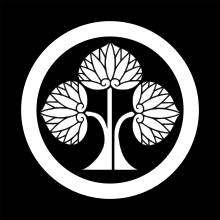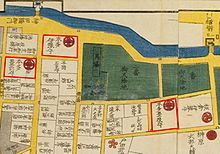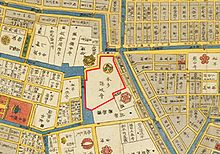Honda (Klan)
The Honda ( Japanese 本 多 氏 , Honda-shi ) were a branched family of the Japanese sword nobility ( Buke ), which was derived from the Northern Fujiwara ( 藤原 北 家 , Fujiwara hokke ). They made a number of smaller and smaller Fudai daimyo of the Edo period .
genealogy
The family tree begins with Fujiwara no Kanemichi ( 藤原 兼通 ; 925–977). This was followed after ten generations by Honda Sukehide ( 助 秀 ), Sukesada ( 助 定 ), Sukemasa ( 助 政 ), Sadamichi ( 定 通 ), Sadatada ( 定 忠 ), Sadasuke ( 定 助 ), Suketoki ( 助 時 ), Suketomo ( 助 豊 ), Tadatake ( 忠 高 ), all of which were nicknamed Heihachirō ( 平 八郎 ) and finally Tadakatsu ( 忠 勝 ).
Four main lines of Honda can be distinguished in the Edo period:
- the Tadakatsu lineage,
- the Masunobu Line,
- the Yasushige line,
- and the Tadatsugu line.
Tadakatsu line
Main line
- Tadakatsu ( 忠 勝 ; 1548–1610) established the main line of this branch. He was a companion of Tokugawa Ieyasu on all his campaigns. When Ieyasu received the Kantō provinces in 1590, Tadakatsu got the Ōtaki castle in Kazusa province with an income of 100,000 koku . After the Battle of Sekigahara he also received the Kuwana Castle in the province of Ise with 150,000 koku.
- Tadamasa ( 忠 政 ; 1575–1631), a son of Tadakatsu, followed him in office. In 1617 he received Himeji Castle in Harima Province with 250,000 koku.
- Masatomo ( 政 朝 ; 1599–1638) held Ōtaki after Tadatomo's death, which was relocated to Tatsuno with 50,000 koku, then Himeji-Shinden, and Himeji after Tadamasa's death.
- Masakatsu ( 正 勝 ; 1614–1671), son of Tadatomo ( 忠 朝 ; 1582–1615), another son of Tadakatsu and daimyo at the Ōtaki castle in Kazusa province with 50,000 koku, took over the main line with Himeji in 1638. A year later he received Kōriyama Castle with 90,000 koku.
- Masanaga ( 政 長 ; 1633–1679), Masatomo's son, took over Kōriyama.
- Tadakuni ( 忠 国 ; 1666-1704) was adopted by Masanaga and received after his death the castle Fukushima in the province of Mutsu and 1684 the castle Himeji.
- Tadataka ( 忠孝 ) received Murakami Castle in Echigo Province in 1704 , then died in 1709 without an heir. A relative continued the line, but was moved to Kariya Castle in Mikawa Province with 50,000 koku, then to Koga Castle in Shimousa Province . His descendants resided at Hamada Castle in Iwami Province from 1759 , then from 1769 at Okazaki Castle in Mikawa Province with 50,000 koku until 1868. Then Vice Count.
Sidelines
- A sideline resided from 1746 in a permanent house ( jin'ya ) in Izumi in the province of Mutsu with 10,000 koku. After 1868 Vice Count.
- Another sideline resided from 1679 in a permanent house ( jin'ya ) in Yamasaki in the province of Harima with 10,000 koku. After 1868 Vice Count.
Masanobu line
Main line
- Masanobu ( 正 信 ; 1539-1617) served Ieyasu. In 1589 he was appointed Sado no kami , became governor of Kanto and was daimyo at Takatori Castle in Yamato Province with 30,000 koku.
- Masazumi ( 正 純 ; 1556–1637), Masanobu's son, served Ieyasu as house elder ( shitsuji ) in Sumpu, today's Shizuoka, then Tokugawa Hidetada in the same capacity in Edo. In 1619 he became a daimyo at Utsunomiya Castle in Shimotsuke Province with 145,000 koku. However, in 1622 he was deposed and had to go into exile in Dewa , where he also died.
Sideline
- Masashige ( 正 重 ; 1545-1617), a brother of Masanobus, founded a branch that started in 1616 at Sōma Castle in Shimousa Province , from 1703 at Numata Castle in Kōzuke Province and from 1730 at Tanaka Castle in the Province Suruga resided with 30,000 koku. After 1868 Vice Count.
Yasushige line
- Yasushige ( 康 重 ; 1554-1611), Bungo no kami and from 1590 daimyo at Shirai Castle in the Kōzuke Province , was transferred to Okazaki Castle with 50,000 Koku in 1601. His descendants resided at Yokosuka Castle in Tōtōmi Province from 1645 , Murayama Castle in Dewa Province from 1682 , Itoigawa Castle in Echigo Province from 1701 and finally at Iiyama Castle in Shinano Province from 1717 with 20,000 Koku . After 1868 Vice Count
Tadatsugu line
Main line
- Tadatsugu ( 忠 次 ; 1549–1613) inherited Ina Castle in Mikawa Province, which had been in the hands of his family for several generations.
- Yasutoshi ( 康 俊 ; 1570-1622) was appointed daimyo in 1601 at Nishio Castle in Mikawa Province. In 1607 he was transferred to Zeze Castle with an income of 30,000 koku. His successors resided at Nishio Castle from 1620, at Kameyama Castle in the province of Ise from 1636 , and back at Zeze from 1651. They stayed there until the Meiji Restoration in 1868 with 60,000 koku. Then Vice Count.
- Yasunaga , a grandson of Yasutoshi, continued the main line.
Sidelines
- Tadasuke , a son of Yasutoshi, started a sideline who resided in a permanent house in Nishibata, Mikawa Province, with an income of 10,500 koku until 1868. Then Vice Count.
- Yasumasa , another grandson of Yasutoshi, founded a lineage that initially resided in Nishishiro in the Kawachi province until 1720 when it was given a permanent house in Kambe in the Ise province. The descendants resided there until 1868 with an income of 15,000 koku. After 1868 Vice Count.
Remarks
Individual evidence
- ↑ Furusawa, Tsunetoshi: Kamon daichō . Kin'ensha, undated, ISBN 4-321-31720-7 , pp.
- ↑ a b c d e Excerpt from the district maps Daimyo Koji , Surugadai , Nihonbashi-kita , Hatchobori and Honjo from around 1850.
- ↑ 寛 永 諸 家 系 図 伝 索引 . Yagi Shoten, 1997, ISBN 4-7971-0251-9 , pp. 42 ( limited preview in Google Book search).
- ↑ 武 家家 伝 本 多 氏 . In: www2.harimaya.com. Retrieved June 1, 2016 (Japanese).
literature
- Papinot, Edmond: Historical and Geographical Dictionary of Japan. Reprinted by Tuttle, 1972 edition of 1910 edition. ISBN 0-8048-0996-8 .
- Takahashi, Ken'ichi: Kamon - Hatamoto Hachiman koma. Akita Shoten, 1976.
- Miura, Masayuki (Ed.): Shiro to jin'ya. Tokoku-hen. Gakken, 2006. ISBN 978-4-05-604378-5 .
- Miura, Masayuki (Ed.): Shiro to jin'ya. Saikoku-hen. Gakken, 2006. ISBN 978-4-05-604379-2 .









